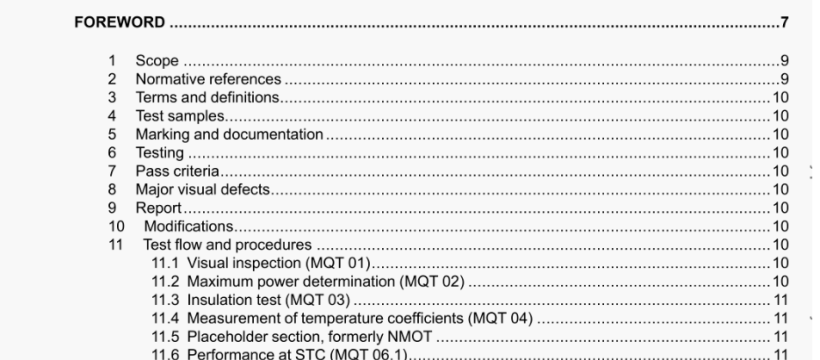UL 61215-1-3-2021 pdf download.Terrestrial Photovoltaic (PV) Modules – Design Qualification and Type Approval – Part 1-3: Special Requirements for Testing of Thin-Film Amorphous Silicon Based Photovoltaic (PV) Modules.
This document is intended to apply to all thin-film amorphous silicon (a-Si; a-Si/uc-Si) based terrestrial flat plate modules. As such, it addresses special requirements for testing of this technology supplementing IEC 61215-1:2021 and IEC 61215-2:2021 requirements for testing. This document does not apply to modules used with concentrated sunlight although it may be utilized for low concentrator modules (1 to 3 suns). For low concentration modules, all tests are performed using the irradiance, current, voltage and power levels expected at the design concentration. The object of this test sequence is to determine the electrical characteristics of the module and to show, as far as possible within reasonable constraints of cost and time, that the module is capable of withstanding prolonged exposure outdoors. Accelerated test conditions are empirically based on those necessary to reproduce selected observed field failures and are applied equally across module types. Acceleration factors may vary with product design and thus not all degradation mechanisms may manifest. Further general information on accelerated test methods including definitions of terms may be found in IEC 62506. Some long-term degradation mechanisms can only reasonably be detected via component testing, due to long times required to produce the failure and necessity of stress conditions that are expensive to produce over large areas. Component tests that have reached a sufficient level of maturity to set pass/fail criteria with high confidence are incorporated into the IEC 61215 series via addition to Table 1 in IEC 61215-1. In contrast, the tests procedures described in this series, in IEC 61215-2, are performed on modules. This document defines PV technology dependent modifications to the testing procedures and requirements per IEC 61215-1:2021 and IEC 61215-2:2021.
11.19.1 Criterion definition for stabilization For the definition of stabilization as per MQT 19 of IEC 61215-2:2021 x= 0,02 shall be used. Any kind of storage shall be done at temperature below 25 °C to avoid thermally activated processes affecting MQT 06.1 of IEC 61215-2:2021 measurement. 11.19.2 Light induced stabilization procedures This test of IEC 61215-2:2021 is applicable with the following modifications. 11.19.2.1 Apparatus for indoor stabilization In IEC 61215-2:2021, 4.19.3.1 replace item d) with: “Use the reference device to set the irradiance between 600 W/m2 and 1 000 W/m2. Record the irradiance.” In IEC 61215-2:2021, 4.19.3.1 replace item e) with: “During the simulator exposure, the module temperature shall stay below 55 °C.” NOTE Most a-Si containing active layers are known to anneal at module temperatures above 55 °C very quickly.
11.19.2.2 Requirements for outdoor exposure for stabilization This test of IEC 61215-2:2021 is not applicable 11.19.3 Other stabilization procedures At present no alternative stabilization methods are applicable. 11.19.4 Initial stabilization (MQT 19.1) Initial stabilization is performed on all modules. Initial stabilization shall be obtained by exposing the modules to simulated sunlight. To fulfil MQT 19 requirements using light exposure, a minimum of two intervals each of at least 43 kWh/m2 are required. After this preconditioning all of the test modules shall be measured for STC power (MQT 06.1 of lEC 61215-2:2021). Output power determination shall be performed after a minimum cooling time of 30 min. Exposure doses of 200 kWh/m2 to 400 kWh/m2 are typically necessary to reach stabilization of amorphous silicon thin-film modules. 11.19.5 Final stabilization (MQT 19.2) Final stabilization is performed on all modules after the test sequences to prove fulfilment of gate No. 2 requirement of IEC 61215-1:2021.UL 61215-1-3-2021 pdf download.
UL 61215-1-3-2021 pdf download
